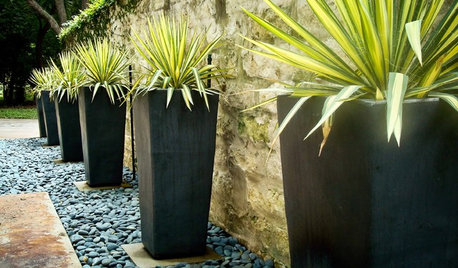Can one use Sevin selectively
non-greenthumb
15 years ago
Related Stories

RUGSA Rug Can Make a Room — but What Kind to Choose?
The perfect rug may be all you need to complete your decor with color, texture and coziness. Here’s how to select the right type
Full Story
ROOFSWhat to Know Before Selecting Your Home’s Roofing Material
Understanding the various roofing options can help you make an informed choice
Full Story
WALL TREATMENTSCan't Find the Right Wallpaper? Make Your Own
For one-of-a-kind walls, just use your imagination. Custom wallpaper is easier and less expensive than you might expect
Full Story
BUDGET DECORATINGThe Cure for Houzz Envy: Living Room Touches Anyone Can Do
Spiff up your living room with very little effort or expense, using ideas borrowed from covetable ones
Full Story
KITCHEN DESIGNTrend Alert: Swinging Doors Can't Miss for Convenience
Create accessibility and elegance in one fell swoop with a swinging door modernized for today's homes
Full Story
DECORATING GUIDESWhat Matisse Can Teach Us About Interior Design
Learn to pack a punch with decor inspired by one of the most influential artists of the 20th century
Full Story
CONTAINER GARDENSWant Compelling Garden Minimalism? Think One Plant, One Pot
Highlight a show-worthy stunner or elevate a pedestrian plant by giving it a solo starring role in the garden
Full Story
KITCHEN DESIGN8 Kitchen Sink Materials to Consider
Learn the pros and cons of these common choices for kitchen sinks
Full Story
KITCHEN DESIGN12 Great Kitchen Styles — Which One’s for You?
Sometimes you can be surprised by the kitchen style that really calls to you. The proof is in the pictures
Full Story
HOUZZ TOURSHouzz Tour: Innovative Home Reunites Generations Under One Roof
Parents build a bright and sunny modern house where they can age in place alongside their 3 grown children and significant others
Full StoryMore Discussions







davidandkasie
alfie_md6
Related Professionals
Cottonwood Landscape Architects & Landscape Designers · Ferndale Landscape Architects & Landscape Designers · New Mexico Landscape Architects & Landscape Designers · Manchester Landscape Contractors · Middletown Landscape Contractors · Canby Landscape Contractors · Fort Atkinson Landscape Contractors · Framingham Landscape Contractors · Kahului Landscape Contractors · Manhattan Landscape Contractors · Paterson Landscape Contractors · St. Louis Landscape Contractors · Vashon Landscape Contractors · Wanaque Landscape Contractors · Goldenrod Landscape Contractorsbigfoot839
Belgianpup
Melissa Houser
betteboo
rose_nutty
aka_peggy
engineeredgarden
tn_veggie_gardner
marymd7
wayne_5 zone 6a Central Indiana
oldroser